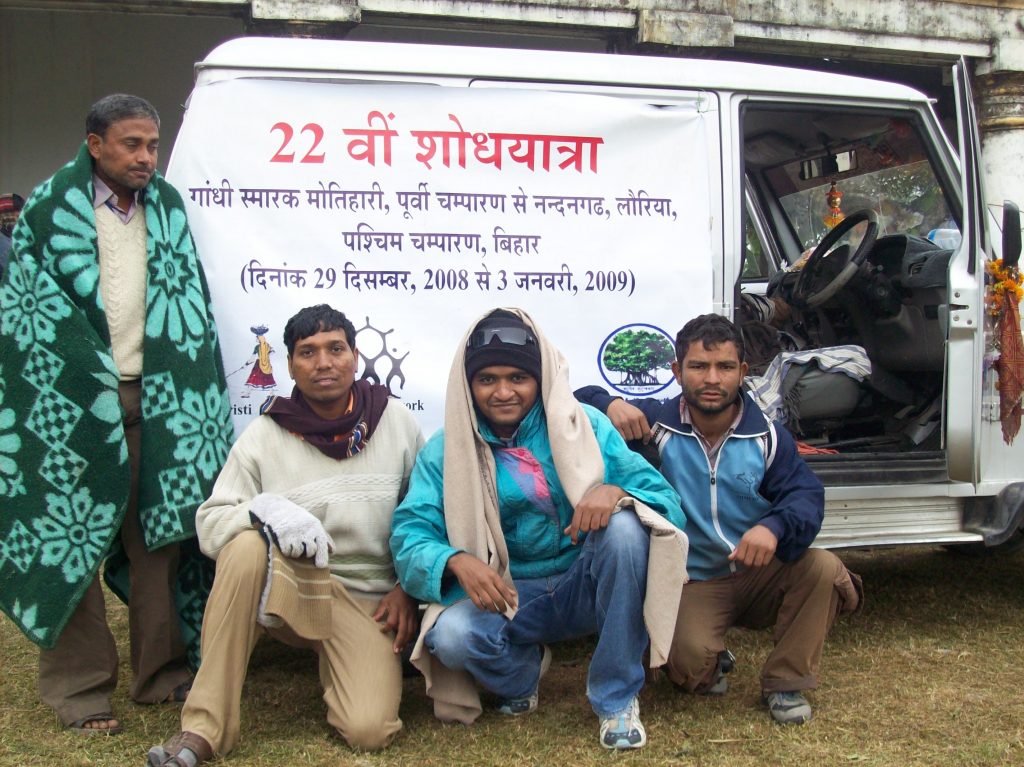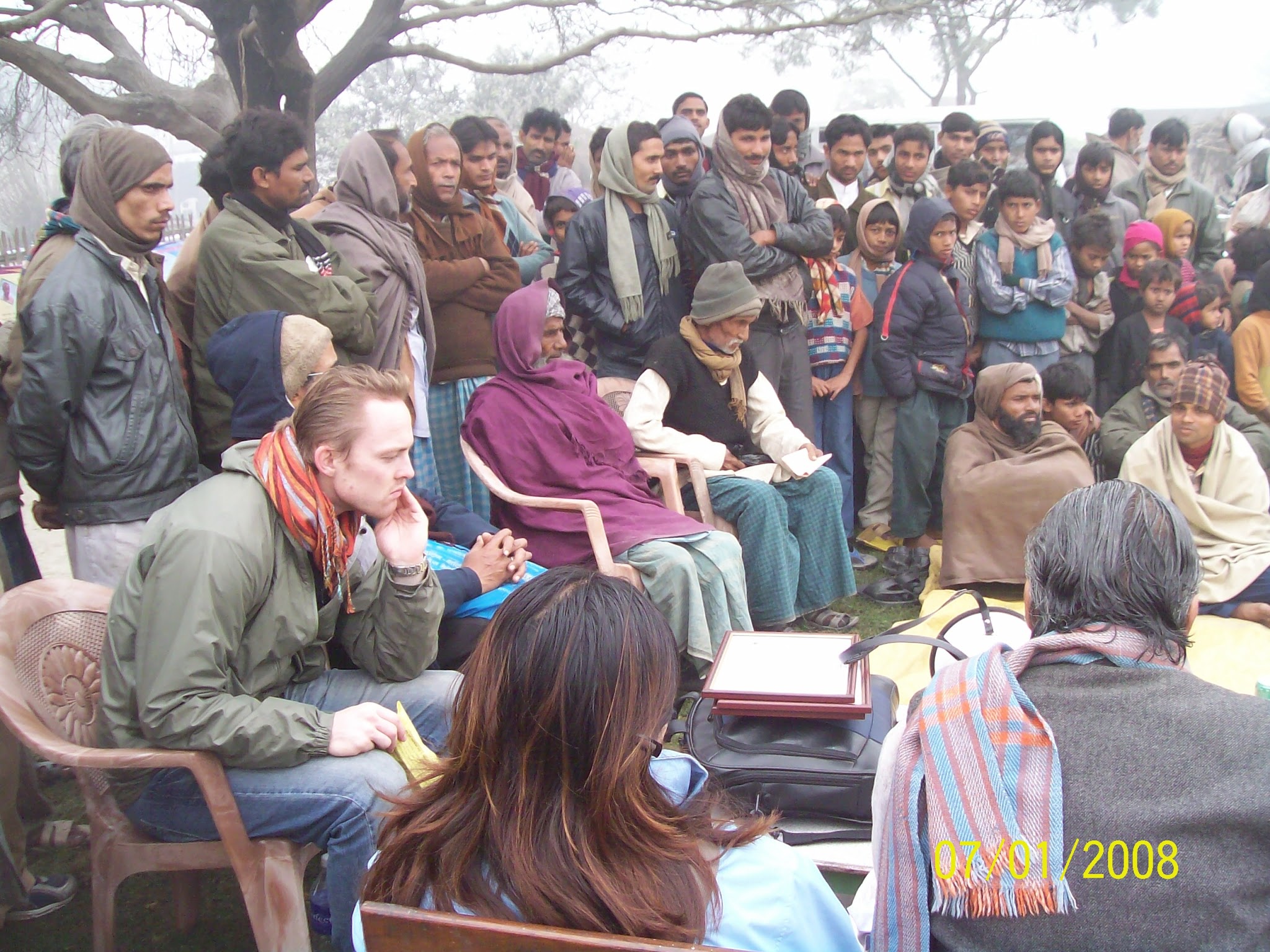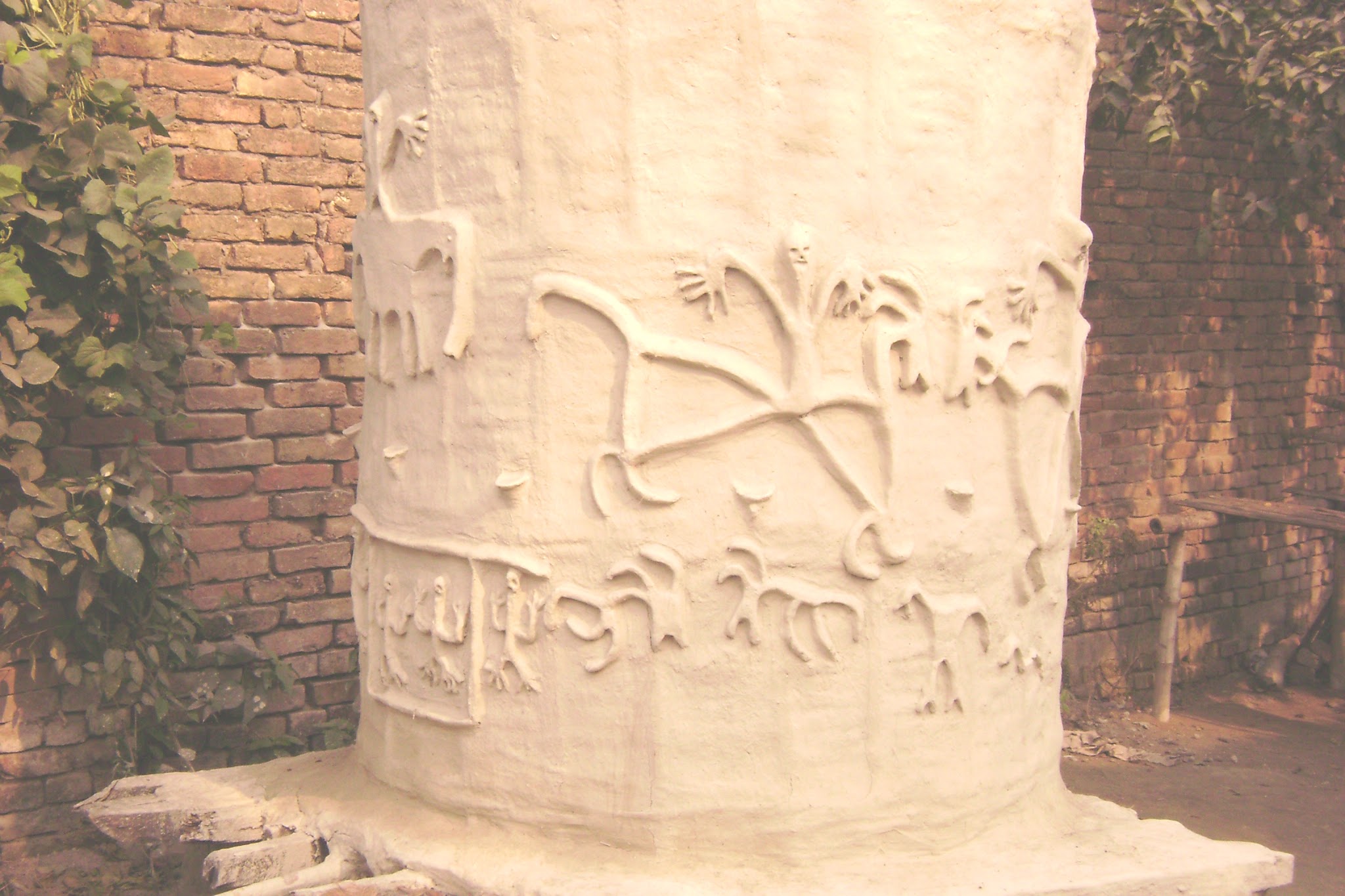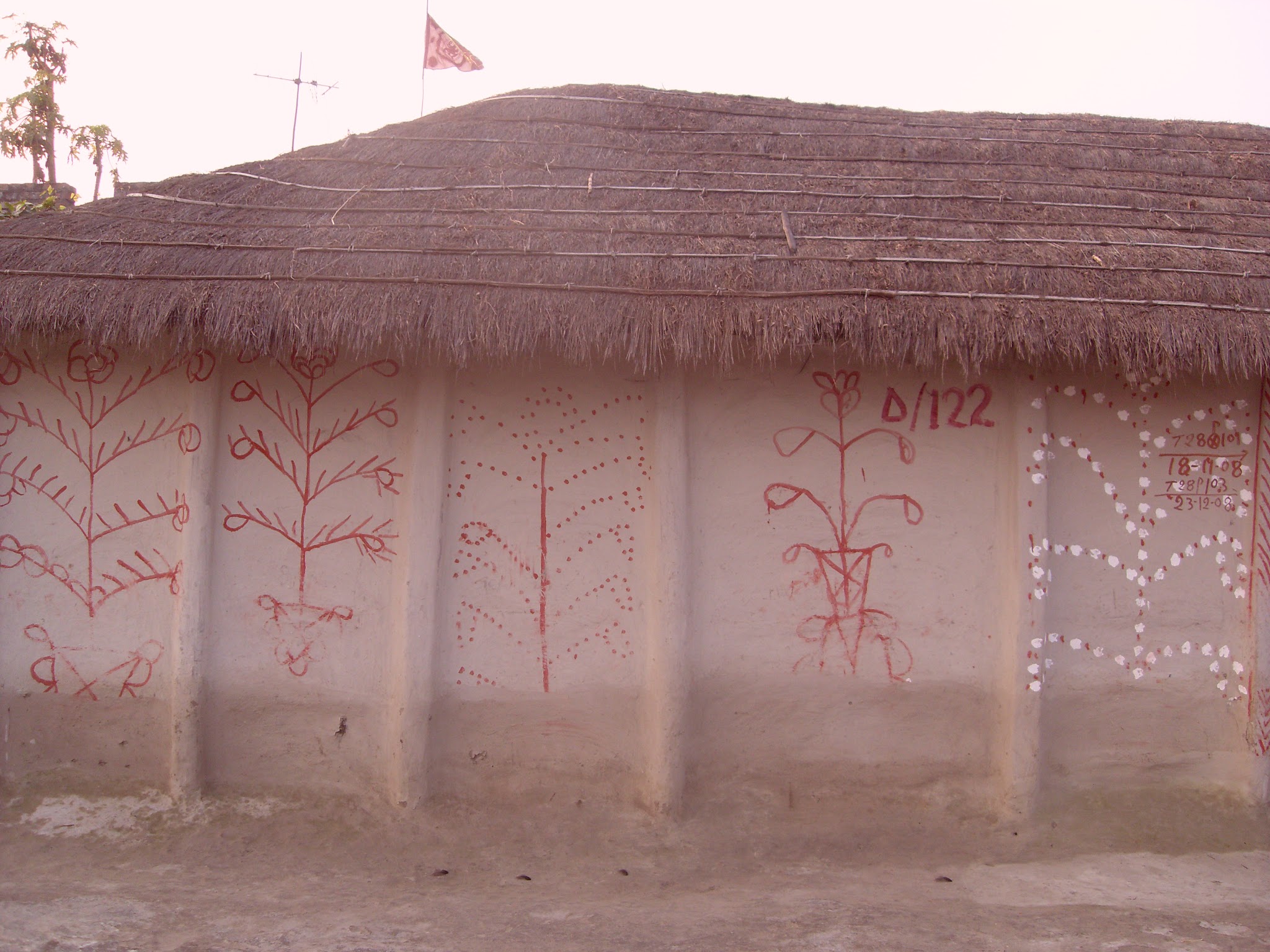Get Next Shodhyatra Update:
Phone:
079-27913293, 27912792
Email:
shodhyatra@sristi.org
22ND SHODHYATRA - MOTIHARI TO LAURIYA (BIHAR)
THE CALL FROM CHAMPARAN
We saw in this ShodhYatra one of the most beautiful etchings on a grain bin, a young student who represented his ideas at international platform, innovators who had solved problems of pollution, drudgery, transportation, etc., and met traditional knowledge holders who shared their knowledge generously. The 22nd Shodhyatra started from Motihari on 29thDecember, 2008 and concluded in Lauria on 3rd January, 2009. A question still remained unanswered. Why did not this place transform economically for so long?
Champaran has a special place in the history of the country because Gandhi perfected the instrument of Satyagrah here in 1917 after lessening the exploitation of indigo farmers within six months. This experience eventually led to the call for full freedom in 1929.
When Shri Raj Kumar Shukla and others invited him to study the problems of indigo cultivators, Gandhi may not have anticipated the degree of exploitation.
The tragedy is that even after 60 years of independence, the exploitation of the poor has not ended significantly. The wage rates are extremely low and economic opportunities are very limited. And yet, the knowledge system is very rich. Even before the ShodhYatra formally began on 29th Dec 2008, the learning exploration started on 28th night itself. Shri Birendra Kumar Sinha had invented a silencer cum pollution control device. Shri Rozadin had developed a very ingenious coffee-making machine (see accompanying box on innovations encountered during the ShodhYatra).
HOMAGE TO GANDHI
One of the questions raised in the inaugural session near Gandhi memorial was, “why do we need ShodhYatra, shouldn’t such creative people have been known to people not only in every village but also everywhere else ?” There was no satisfactory answer to this question. One could blame it on the prevalent mindset, colonial history, post-colonial obsession with exogenous models of development or just the inertia among the developmental practitioners.
After paying homage to Gandhi, we started the walk. Many old time Gandhians bemoaned the fact that Motihari never got the place in Indian history as it deserved.
Paintings of a young boy, Santosh in Banjaria village, left everybody spellbound. He expressed his artistic talent in a wide range of ways.
Just before leaving for the next village, suddenly there was an extraordinary sight in front of us. A circular grain bin made of clay outside one of the houses had extraordinary art work all around on the surface. We inquired about the artist and thus discovered Smt Ram Tiwari Devi, Chailaha village, who had made the three dimensional artwork on the grain bin (khop).
She had learnt this art from her mother and felt that it was the only way she knew making a grain bin. When art becomes the only alternative, creativity achieves its purpose. For the rest of the journey, we kept on looking for similar designs, and did find nice paintings and sketches. But, we could not find even one more bin with similar three-dimensional or embossed artwork. For more than 100 km, not one replication of the design (though some variations of less complex designs were indeed seen) was encountered. Did she know how distinctive she was? Would the planners and thinkers consider learning about humility from such artist for whom the workspace is co-terminus with life and art space, amidst all the struggles for survival? Readers may recall a similar artwork in Baghpat, Uttar Pradesh, on a roadside dung cake heap, and on a wall of a hut in Purulia, West Bengal. Every time we witness such signatures of women’s creativity manifested in the spaces accessible to them, we become conscious of what could have been the potential if they had been given better institutional space instead of only domestic space.
After crossing Ajgari village, we took lunch at Gokhula and passed through a site where there was a memorial known as Battakh Miya ki Majar, Mohamedpur. Battakh Miya was a freedom fighter long forgotten, only recently remembered. Here the yatris met Shri Karmoola Khan, 60, who was a local healer and used to give medicine for pyorrhoea and many other ailments including sprains, stomach ache, etc. Just consuming black pepper (Piper nigrum L.) for a month everyday in the morning was supposed to help in the sciatica pain. While passing through Siswaniya, Gobari and Mokhalishpur, we showed innovations from other parts of the country on a laptop with both sided screen developed by Dr Janardhan Reddy and Shri Narayan of Chennai. We stayed at Bhela Chhepra Primary School. From there, we proceeded to Semra. At Chapra Bahas, a freedom fighter Shri Baidnath Prasad sang a patriotic song and shared his knowledge of herbal medicine. After facilitating him, ShodhYatris facilitated another freedom fighter, Janab Sheikh Yusuf at his house.
At Sugauli, there was a recipe competition among school children and also a small function organised to honour local healers and innovators. We stopped by at the house of Shri Pramod Stephen who had been serving the local communities through traditional medicine. On the way to Madhopur Krishi Vigyan Kendra, we came across several interesting innovations and depressing sites of closed down sugar mills. A young boy, Abhay Kumar Yadav, class VII of Sripur chowk had made an electro magnetic collector of metallic pieces from the waste/ compost so that these pieces did not reach the field and hurt the animals. Shri Stephen carried a flag all along the yatra with a slogan, ‘‘Neeche dharti upar akash, beech se nikle gyan ka prakash” (a blue sky above the earth, the light of knowledge emanates in between). On the way to Jaukhatiya, we observed two labourers cutting dried palm tree trunk on a makeshift stand. This was an interesting design which most yatris had not seen before. One of the yatris had a pain in his leg and a herbal healer, Shri Ganesh Baitha came to rescue. After he suggested the medicine, yatris asked him as to how did he learn it in the first place? Shri Ganesh replied poetically, Kekra se kahal bekar ba, murkh koi naikhe sabe hoshiyar ba (What to say to whom, nobody is foolish, everybody is intelligent).
Later, at Motilal High School, Manjhwaliya and Primary School at Mahodipur, interesting discussion took place about how to generate local solutions using biodiversity in the region. Example of a lesson learnt in Kutch, Gujarat was narrated where a farmer after listening to the importance of herbal pesticides, summarized his understanding as: “all plants which were not eaten by animals could be a source of herbal pesticide”. Farmers found such an insight very practical and worth trying.
The erosion of knowledge due to weakening of the ties between grandparents and grand children was also discussed. After reaching Shri Bipin High School, Bettiah, late in the night, most yatris were very tired. But some wanted to celebrate the dawn of New Year. Next day was very insightful because several innovators such as Nishant, Sandeep, Meraz , Janki Devi and other knowledge holders joined the Yatra. On the way to Ranipur we also stayed for a few minutes at the ancient temple of Kalimata. When we reached Bunyadi Vidyalaya, Ranipur, the students and teachers had organized a very elaborate function. This was the first Bunyadi Vidyalaya set up by Gandhiji after a six-day national conclave organized at Vrindavan village in 1939. A memorial had been built viz., Prerna Kuti, maintained since then by Shri Mathura Bhagat.
One of the highlights of the function at the Bunyadi Vidyalaya was a speech by Rohit Kumar Mishra, a class 11 student who had represented his village in an international youth festival in Norway. After the function, all the yatris visited Prerna Kuti and listened to the interesting anecdotes about Gandhiji from Shri Mathura Bhagat.
It was already late in the evening, but Shri AS Prakasha Rao, principal of Jawahar Navodaya Vidyalaya was very responsive and had invited 400 students to interact with the ShodhYatris. Vishwa Bharti won the first prize for an idea of egg shell breaking machine. Ideas about a modified pressure cooker and machine for cutting & cleaning vegetables were suggested by Ramu Kumar. At the next stop, ShodhYatris relished several local recipes such as guma ka sag, gular ka halwa, and mahua ka halwa. Guma [Leucas aspera (Willd.) Link.] is a plant that was found along the road side in the depressions almost all along the ShodhYatra route. Its leaves were reported to have pain relieving effect and its roots were helpful in toothache. Plants like these can become the anchor of local knowledge based enterprises. Given its widespread presence, there is a very little chance that poor people will be excluded from accessing it.
The visit to Shaheed Chowk, Bettiah was a memorable one. During the Nav Nirman movement of Jai Prakash Narayan, several youth activists were killed in police action. This memorial is built in their memory. All Yatris were received by Meraz here and then introduced to his young team trying to bring about an educational transformation.
While Shri Sinha’s pollution control device was bigger in size, Shri Nandeshwar Sharma has designed a compact silencer cum pollution control device similar to an exhaust pipe of a two wheeler. On the last day, after passing through Padri, Kudwa Mathiya, we reached Marahia. There were some labourers who were watching us from a distance and whose confidence we could not win enough to get them to join us. On the way to Lauria, the last stop, we halted at Nandangarh fort and a Buddhist Stupa. The marvel of 2000 year old technologies, particularly of brick laying and architecture were visible before our eyes. The local villagers showed us how people at that time mixed pulses and some other grains in the clay while baking the bricks. Isn’t it ironic that a technology which has stood the test of the time for 2000 years is still waiting for recognition and formal assimilation in the modern science, technology and institutional structures?
A question remained unanswered. Why the call of freedom from poverty, exploitation and domination, given by the Father of Nation so long ago was not really answered properly in all these years? Economic freedom is something that still remains to be achieved by a large majority. May be this walk will imbue in us, a determination to persist with the missions of finding selfreliant, decentralized entrepreneurial alternatives based on local knowledge, resources, and institutions.
FLICKR GALLERY













